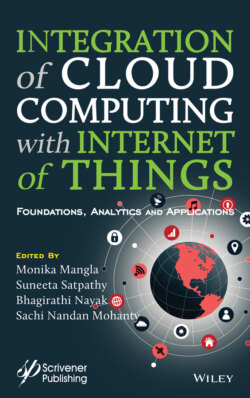Читать книгу Integration of Cloud Computing with Internet of Things - Группа авторов - Страница 25
1.5 Semantic IoT (SIoT)
ОглавлениеThe reflection of heterogeneity on these raw data for meaningful interpretation and detection of events in real-world environments makes the IoT platform more complex. The total number of IoT domains included in 2016 is approximately 450 with an exponential rise in new IoT platforms each year [26]. By the year 2020, the number of IoT devices may reach around 50 billion with numerous heterogeneous services and applications [2]. In this accord, the SIoT concerns to a worldwide network of interconnected devices, things, heterogeneous objects, and services which can be uniquely addressable and accessible using some sort of standard communication protocols.
The steps involved in managing heterogeneous data sources for making SIoT effective are based on SEG 3.0 methodology as shown in Figure 1.9. It supports the SI from the data generation to the end-users.
Due to the involvement of a huge number of things and the services in the future IoT, it remains a challenge to represent, interconnect, store, search, address, and organize relevant information available from different IoT sources. Thus, the involvement of semantics in IoT remains crucial to provide adequate modeling, reach desired solutions for things description, and reason over IoT generated data. With an increase in demand for applications and services using semantic sensor web, the research community, and software developers are designing advanced system architecture to automatically transform data from sensors to semantic expression. The use of data somatization facilitated the end-users to understand and reason on sensor-related human’s activities for effective dynamic environments. The use of SI remains vital for adequate representation and integration of huge amounts of data arrived from different IoT sources for their effective utilization. The information extracted semantically from high-level abstractions or data can provide a potential solution to reduce the heterogeneity in a shared or common IoT platform. The Semantic Interoperability (SI) assisted by the SW to facilitate consolidated technologies, standards, and languages by providing data as well as IoT platform interoperability. With an ever increasing demand in applications and their developments, the use of semantic interoperability in IOT domain remains significant and essential for its success. With many different smart technologies, the SI integration costs are likely to rise and the system becomes complex. Nevertheless, with thousands of potential data sources, application areas, industries, and customers, a smart city can be smarter with the combination, cross-compilation, and re-utilization of data generated by individual applications using SI. The intersection of different IoT visions is shown in Figure 1.10.
Figure 1.9 The steps of SIoT (SEG 3.0 methodology) [27].
A generalized SIoT architecture is shown in Figure 1.11.
It is not enough to gather data but requires an ability to convert or process the available data into fruitful decisions or information that can provide an edge in SI. For instance, if someone was to call an end-user on their phone and speak in London, most users would probably not be able to communicate or achieve a meaningful result. The same issue occurs in communication between things when they use implementation-specific data models.
Figure 1.10 Intersection of different IoT visions [2].
Figure 1.11 A generalized architecture of including semantics.
